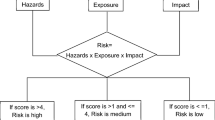Abstract
One of the major factors affecting the sustainability of agricultural production is flood and erosion. Increased population pressure is one of the leading factors causing flood and erosion resulting in forest/wood land clearance for wood and smallholding agriculture; traditional agricultural practices; and declining land productivity which result in less vegetation growth and expose more land surface area to erosions. Available information on floods and erosion and knowledge of the areas that are likely to be affected during flooding and erosion helps to mitigate the risk of flooding and erosion. This chapter adopts GIS as a tool to identify and map flood and erosion risk areas in Osun state. Three category risk zones: high, medium, and low risk zones were identified from the erosion and flood risk map generated. The flood risk map shows that high risk zones covered land area of 1210 sq km, medium risk zones covered land area of 5290.2 sq km, and low risk zones covered land area of 7970 sq km. The erosion risk map shows that the high risk zones for erosion covered land area of 820 sq km, medium risk zones covered land area of 5660 sq km, and low risk zones covered land area of 8310 sq km. Finally, recommendations on strategies for militating against flood and erosion risks were discussed and if implemented it will help the Nigerian government authorities to improve on flood and erosion management in the affected state.
Similar content being viewed by others
Abbreviations
- DEM:
-
Digital Elevation Model
- ENVI:
-
Exelis Visual Information Solutions
- ESRI:
-
Environmental Systems Research Institute
- ETM+:
-
Enhanced Thematic Mapper Plus
- FAO:
-
Food and Agricultural Organization
- FGN:
-
Federal Government of Nigeria
- FME:
-
Federal Ministry of Environment
- GIS:
-
Geographic Information Systems
- GLCF:
-
Global Land Cover Facility
- NDVI:
-
Normalized Difference Vegetative Index
- RS:
-
Remote Sensing
- SRTM:
-
Shuttle Radar Topography Mission
- TM:
-
Thematic Mapper
References
Akpokodje EG, Tse AC, Ekeocha N (2010) Gully erosion geo-hazards in southeastern Nigeria and management implications. Sci Afr 9(1):20–36
ASABE (2002) In defense of soil and water resources in the United States: Soil erosion research priorities. St. Joseph, Mich.: ASAE. Available at: www.asabe.org/news-public-affairs/public-affairs/position-statements/soil-erosion-program.aspx. Accessed 19 December 2012
Aweto AO (1994) Soils of Ibadan region. In Filani MO, Ikporukpo FO, Areola CO (eds) Ibadan region. Rex Charles Publication, Ibadan, pp 45–57
Ezezika OC, Adetona O (2011) Resolving the gully erosion problem in southeastern Nigeria: Innovation through public awareness and community-based approaches. J Soil Sci Environ Manag 2:286–291
D’Hoore JL (1964) Explanatory Monograph for the 1:5m Soil Map of Africa, CCTA Joint Project, No. 11, Lagos
Hopkins B (1965) Forest and Savanna, Ibadan
Hughes AO, Prosser IP, Stevenson J, Scott A, Lu H, Gallant J, Morgan CJ (2001) Gully erosion mapping for the National Land Water Resources Audit. Technical Report 26/01, CSRO Land and Water, Camberra, Australia
Igbokwe JI, Akinyede JO, Alagac T, Anike LO (2008) Mapping and monitoring of impact of gully erosion in southern Nigeria with satellite remote sensing and geographic information system. Int Arch Photogramm Remote Sens Spat Inf Sci 37:865–871
Jeb DN, Aggarwal SP (2008) Flood inundation hazard modeling of the river Kaduna using remote sensing and geographic information systems. J Appl Sci Res 4(12):1822–1833
Kostadinova S (2002) Erosion and torrent control in mountainous region of Serbia. Proceedings keynote paper. International year of mountainous conference: “natural and socio-economic effect of erosion control in mountainous regions”, Belgrade
Nasir MJ, Iqbal J, Ahmad W (2020) Flash Flood risk modeling of swat river sub-watershed: a comparative analysis of morphometric ranking approach and el-shammy approach. Arab J Geosci 13(20):1–19
Obiadi II, Nwosu CM, Ajegwu NE, Anakwuba EK, Ezim OE (2011) Gully Erosion in Anambra State, south east Nigeria: issues and solution. Int J Environ Sci 2(2):795–804
Ofomata GEK (1965) Factors of soil erosion in Enugu area of Nigeria. Niger Geogr J 8(1):45–59
Ojo OI, Olawale SO (2014) Assessment of weather variability impact on cassava yield in South Western Nigeria. LAUTECH J Engineer Technol 8(2):169–175
Wall G, Baldwin CS, Shelton IJ (2003) Soil Erosion – Causes and Effects Ontario Ministry of Agricultural and Food, Ontario, Canada
Walling DE (2009) The impact of global change on erosion and sediment transport by rivers: current progress and future challenges. Scientific paper: International Sediment Initiative of IHP UNESCO, 2009
Author information
Authors and Affiliations
Corresponding author
Editor information
Editors and Affiliations
Rights and permissions
Copyright information
© 2021 Springer Nature Switzerland AG
About this entry
Cite this entry
Ojo, O.I., Awujoola, O.O., Ilunga, M.F. (2021). Flood and Erosion Risk Assessment Mapping. In: Leal Filho, W., Luetz, J., Ayal, D. (eds) Handbook of Climate Change Management. Springer, Cham. https://doi.org/10.1007/978-3-030-22759-3_174-1
Download citation
DOI: https://doi.org/10.1007/978-3-030-22759-3_174-1
Received:
Accepted:
Published:
Publisher Name: Springer, Cham
Print ISBN: 978-3-030-22759-3
Online ISBN: 978-3-030-22759-3
eBook Packages: Springer Reference Earth and Environm. ScienceReference Module Physical and Materials ScienceReference Module Earth and Environmental Sciences




